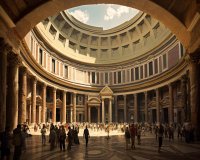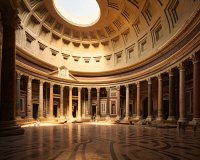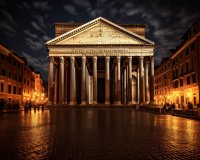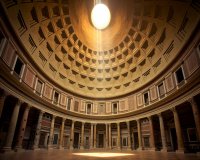The Gods of the Pantheon: Who Were They and Why Were They Worshipped?
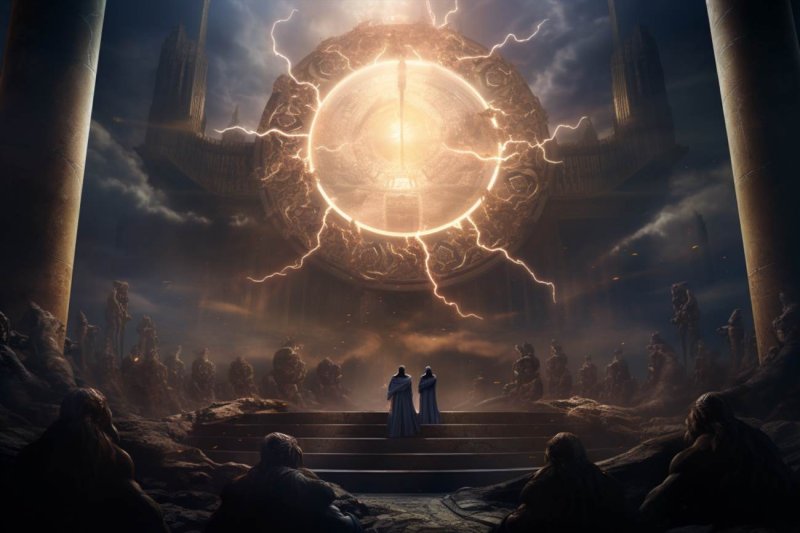
The Gods of the Pantheon: Who Were They and Why Were They Worshipped in Rome
The Roman Pantheon, a majestic temple in the heart of ancient Rome, was dedicated to the worship of a myriad of gods and goddesses. The religious beliefs of the Romans were deeply intertwined with their daily lives, and the pantheon reflected the rich tapestry of their spiritual convictions.
The Pantheon's Origins:
The construction of the Pantheon dates back to the reign of Marcus Agrippa around 27 BC, though the current structure is a reconstruction by Emperor Hadrian in the 2nd century AD. The word "Pantheon" itself is derived from Greek, meaning "all the gods," and it was indeed a place where various deities were venerated.
The Divine Assembly:
Within the Pantheon, a panoply of gods and goddesses found their sacred abode. Chief among them was Jupiter, the king of gods, often depicted with thunderbolts in hand. Juno, his wife and sister, and Minerva, the goddess of wisdom, also held significant positions in the divine hierarchy.
The Triad:
One of the central aspects of Roman religious belief was the Capitoline Triad—Jupiter, Juno, and Minerva—who were worshipped collectively as a powerful triumvirate. Each deity brought a unique aspect to the divine equation, symbolizing the multifaceted nature of the Roman worldview.
Mars and Venus:
Mars, the god of war, and Venus, the goddess of love and beauty, were also revered within the Pantheon. The paradox of celebrating both war and love in a shared sacred space reflects the complexity of Roman society, which valued both martial prowess and the softer virtues.
Mercury, Neptune, and Vulcan:
Mercury, the messenger of the gods, Neptune, the god of the sea, and Vulcan, the blacksmith of the divine, rounded out the major gods worshipped in the Pantheon. Each had specific domains and attributes, contributing to the diversity of the Roman religious landscape.
Why Were They Worshipped?
The worship of these gods served various purposes in Roman society. Firstly, it provided a moral and ethical framework, with each deity embodying virtues to which believers aspired. Additionally, religious ceremonies and rituals were integral to communal identity, fostering a sense of unity among the Roman people.
Political and Social Functions:
Moreover, the veneration of gods had political undertones. Emperors often sought to align themselves with specific deities to legitimize their rule, and public ceremonies at the Pantheon reinforced the state's authority. Socially, festivals dedicated to the gods provided occasions for communal celebration and bonding.
The Enduring Legacy:
While the Roman Pantheon fell into disuse as Christianity emerged, its architectural and spiritual legacy endures. The gods of the Pantheon, with their intricate narratives and symbolic significance, remain pivotal in understanding the religious, social, and political dimensions of ancient Rome.
In conclusion, the gods of the Pantheon were not merely figures of myth and legend but integral components of Roman identity. The worship of these deities shaped the cultural landscape of ancient Rome, leaving an indelible mark on the pages of history.
Pantheon Guided Tour
Enjoy a tour of the incredible Pantheon with a local guide. Admire the Pantheon's oculus and Rafaelo's tomb. Learn about Ancient Rome, Michelangelo, and more with your guide.
About this activity
Free cancellation. Cancel up to 24 hours in advance for a full refund. Reserve now & pay later. Keep your travel plans flexible — book your spot and pay nothing today.
Covid-19 precautions
Special health and safety measures are in place. Check your activity voucher once you book for full details.
Duration: 1 hour
Live tour guide: English
Wheelchair accessible
Experience Highlights
- Enjoy a small-group tour
- Learn about the history of Ancient Rome from your local and expert guide
- Explore three of the top ten sights in Rome
Full Description
Your guide will tell you all about the great Michelangelo and his depiction of Christ on the cross. You will also learn about the Basilica of Neptune and the thermal baths. See the original Roman street level, the flood marks, and the marble freezes.
You will also go inside the Pantheon to gaze at the jaw-dropping oculus and to see Rafaelo’s tomb. Along the way, you will hear lots of information as you explore three of the top ten sights in Rome.
Meeting Point
Meet your guide next to the shop "L'Antica Salumeria" - Piazza della Rotonda 4.
Important information
- The Pantheon is a holy place, so guests should dress appropriately — you should cover your shoulders and knees
- Please wear comfortable shoes
From €37 per person
Origin and Significance of the Pantheon Gods in Rome
The Pantheon in Rome stands as one of the most iconic and enduring symbols of Roman architecture and culture. Its origins and the gods associated with it carry significant historical and religious importance.
The Pantheon, originally commissioned by Marcus Agrippa during the reign of Augustus (27 BC – 14 AD), was a temple dedicated to all the gods of ancient Rome. The word "Pantheon" itself is derived from Greek, where "pan" means all and "theos" means gods, signifying its purpose.
The building we see today, however, is a reconstruction by Emperor Hadrian around 126 AD after the original structure was damaged by fire. The design and grandeur of the Pantheon serve as a testament to Roman engineering and architectural prowess.
One of the primary aspects of the Pantheon's significance is its inclusive dedication to all gods. In a polytheistic society like ancient Rome, this reflected the religious beliefs and practices, where various gods held distinct roles and domains.
The Pantheon's architecture is awe-inspiring, featuring a massive dome with an oculus at the center, allowing natural light to illuminate the interior. This design not only showcased the engineering skills of the Romans but also symbolized the divine connection between the heavens and the earthly realm.
The gods worshipped in the Pantheon were diverse, representing various aspects of life and the natural world. Jupiter, the king of the gods and the god of thunder and lightning, was prominently worshipped. Other major deities included Juno, Minerva, Neptune, Venus, and Mars, among many others.
Each god had a unique significance and was revered for different attributes. For instance, Venus was associated with love and beauty, Mars with war and agriculture, and Neptune with the sea. These deities were invoked for blessings, protection, and guidance in different aspects of life.
Visiting the Pantheon and paying homage to the gods was an integral part of Roman religious and social life. People would offer prayers, sacrifices, and rituals to seek favor or express gratitude to the deities. The grand ceremonies and festivities associated with these rituals added to the cultural vibrancy of ancient Rome.
In conclusion, the Pantheon in Rome stands as a remarkable architectural marvel dedicated to the diverse pantheon of gods revered by the ancient Romans. Its origins, reconstruction, and the gods associated with it hold immense historical, religious, and cultural significance, offering a glimpse into the rich tapestry of Roman civilization.
Rome: City Highlights Guided Walking Tour at Dusk or Night
Join your guide on an enchanting stroll through Rome, experiencing the city's major sights including the Piazza Venezia and the Pantheon bathed in the evening or nighttime light. Depending on your chosen tour, meet your guide at Trajan's Column or Piazza Navona. Throughout the journey, your guide will regale you with fascinating stories about the history of the neighborhoods, pointing out highlights such as the Pantheon and Trevi Fountain.
Discover the historical significance of various famous squares and their connection to the unification of Italy and recent history. Pass by Rome's smallest church, a church adorned with a hidden painted illusion, and learn about the stories and scandals of some of Rome's recent politicians. The tour continues to showcase more highlights of this ancient city.
Highlights of the experience include:
- Exploring the Historical Centre of Rome
- Guidance from a Local Tour Guide
- Experiencing the main monuments in the city center
Recommended essentials to bring include comfortable shoes and clothes. Don't miss this chance to explore Rome's rich history and architecture at dusk or night.
The Role and Influence of the Pantheon Gods in the Ancient World Rome
In the ancient world of Rome, the Pantheon gods played a central role in the religious and cultural fabric of the society. The Pantheon, a magnificent temple dedicated to the gods, stood as a testament to the significance of these divine beings in the lives of the Romans.
Origins of the Pantheon:
The word "Pantheon" itself is of Greek origin, meaning "all gods." The Romans adopted and adapted the concept, constructing a grand temple to honor a multitude of deities from their own and other cultures.
Architectural Marvel:
The Pantheon, with its iconic dome and Corinthian columns, showcased the architectural prowess of ancient Rome. The design reflected the Romans' commitment to blending art and religion, creating a sacred space that inspired awe and reverence.
The Pantheon Gods:
The temple housed statues and altars dedicated to various gods and goddesses. Jupiter, the king of gods, Juno, his wife, and Mars, the god of war, were among the prominent figures venerated. Each deity represented different aspects of life, from love to wisdom, and the Romans sought their favor through rituals and offerings.
Religious Practices:
Religious ceremonies at the Pantheon were elaborate affairs, involving priests, incense, and prayers. Citizens flocked to the temple to seek divine guidance, especially during times of war or harvest. The gods were believed to influence every facet of human existence, and appeasing them was crucial for the well-being of the state and its people.
Political Symbolism:
Beyond the religious realm, the Pantheon and its gods held political significance. Emperors often associated themselves with specific deities, using divine connections to legitimize their rule. The temple became a backdrop for imperial propaganda, reinforcing the idea of a ruler ordained by the gods.
Influence on Art and Literature:
The Pantheon gods permeated all aspects of Roman culture, including art and literature. Mythological tales featuring gods and goddesses were popular subjects for artists and writers, shaping the collective imagination of the society. The gods became cultural icons, influencing everything from poetry to public monuments.
Decline and Transformation:
As the Roman Empire faced internal strife and external threats, the influence of the Pantheon gods began to wane. The rise of Christianity marked a significant shift in religious dynamics, leading to the eventual conversion of the Pantheon into a Christian church dedicated to St. Mary and the Martyrs.
Legacy:
Despite its transformation, the Pantheon and the gods it once housed left an enduring legacy. The myths and legends, the architectural marvel, and the religious practices continue to captivate modern imaginations, offering a glimpse into the rich tapestry of ancient Roman life.



